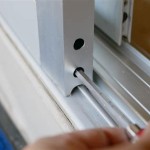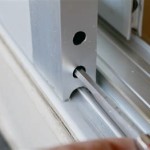How To Replace a Sliding Glass Patio Door
Replacing a sliding glass patio door is a project that, while potentially challenging, can be successfully completed by a homeowner with a reasonable level of DIY experience. This article provides a comprehensive guide to the process, covering essential preparation, removal of the old door, installation of the new door, and final adjustments. Careful planning and adherence to the steps outlined below are crucial for a successful outcome.Before embarking on this project, it's critical to accurately assess the existing door and surrounding frame. The size of the replacement door must match the existing opening. Measure the height and width of the door frame from the inside, taking measurements at the top, middle, and bottom to account for any inconsistencies. Additionally, note the thickness of the wall and the depth of the door frame. This information will ensure that the new door fits correctly and that any necessary adjustments can be made proactively.
Safety should always be the top priority. Working with large glass panels presents inherent risks. Always wear safety glasses, work gloves, and sturdy footwear throughout the entire process. Having a second person assist with lifting and maneuvering the door is highly recommended. Sliding glass doors are heavy and unwieldy, and attempting to handle them alone significantly increases the risk of injury. Furthermore, disconnect any electrical wiring that may be near the door frame before beginning work. This will prevent the possibility of electrical shock.
Gathering all necessary tools and materials before starting significantly streamlines the process. The following is a comprehensive list of items typically required:
*New sliding glass patio door (matching the dimensions of the existing door)
*Measuring tape
*Utility knife
*Screwdrivers (various sizes, including Phillips and flathead)
*Pry bar
*Hammer
*Drill with various drill bits
*Level (at least 4 feet long)
*Shims (wood or composite)
*Caulk gun and exterior-grade caulk
*Construction adhesive
*Safety glasses
*Work gloves
*Putty knife or scraper
*Cleaning supplies (bucket, sponge, soap)
*Reciprocating saw (optional, for cutting trim if needed)
*Helper (highly recommended)
Preparing the Work Area and Removing the Old Door
Before beginning the physical removal of the door, prepare the surrounding work area. Protect the floor and adjacent walls with drop cloths or plastic sheeting to prevent damage from debris and tools. Clear the area of any furniture or other obstructions that might hinder movement. This facilitates a safe and efficient workflow.
The first step in removing the old door is to detach any trim or molding that surrounds the door frame. Use a utility knife to carefully score along the edges of the trim where it meets the wall. This will prevent the paint from peeling and tearing when the trim is pried away. Gently insert a pry bar between the trim and the wall, and carefully pry the trim loose. Work slowly and methodically to avoid damaging the wall or the trim itself, if it is to be reused.
Once the trim is removed, the sliding door panel needs to be taken out. Most sliding doors have adjustable rollers at the bottom. Locate these rollers and use a screwdriver to adjust them until the door is at its highest position. This allows the door to be lifted up and out of the track. With the assistance of a helper, carefully lift the door straight up and out of the frame. Be mindful of the weight and size of the door to prevent dropping it or causing injury. Set the door aside in a safe location.
Next, detach the stationary door panel, if applicable. This panel is typically secured with screws or clips. Locate these fasteners and remove them. Depending on the design, the stationary panel may also need to be lifted up and out of the track. Again, enlist the help of a second person to safely remove the panel.
With both door panels removed, the old door frame can be extracted. Inspect the frame for any remaining screws or fasteners securing it to the wall framing. Remove these screws. Using a pry bar, carefully loosen the frame from the wall. Work around the perimeter of the frame, gradually prying it loose. Be cautious not to damage the surrounding wall. Once the frame is loose, carefully pull it out of the opening. Thoroughly clean the opening to remove any remaining debris, nails, or old caulk.
Installing the New Sliding Glass Patio Door
With the old door and frame removed, the opening is ready for the new sliding glass patio door. Before installing the new frame, apply a bead of construction adhesive around the perimeter of the opening where the frame will make contact with the wall. This will help to create a strong and weatherproof seal.
Carefully position the new door frame into the opening. Ensure that the frame is centered and aligned properly. Shim the frame as needed to ensure that it is level and plumb. Use a level to check the frame both horizontally and vertically. Shims should be placed behind the frame at various points to provide support and maintain alignment. Proper shimming is crucial for the smooth operation of the sliding door.
Once the frame is properly shimmed and aligned, secure it to the wall framing with screws. Use screws that are long enough to penetrate the wall framing securely. Drill pilot holes before inserting the screws to prevent the wood from splitting. Check the level and plumb of the frame again after securing it with screws to ensure that it hasn't shifted during the process.
After securing the frame, install the sliding door panel into the track. Adjust the rollers at the bottom of the door until it rolls smoothly and easily. The door should move freely without binding or sticking. Fine-tune the roller adjustments as needed to achieve optimal performance. Make sure the door latches securely and that the locking mechanism functions properly.
Install the stationary door panel, if applicable, following the manufacturer's instructions. Ensure that the panel is properly sealed and secured to the frame. Check for any gaps or air leaks around the panel and address them as necessary.
Final Adjustments, Sealing, and Finishing
Once the door is installed, thoroughly inspect it for any gaps or air leaks around the frame and door panels. Apply exterior-grade caulk to all seams and joints to create a weatherproof seal. Use a caulk gun to apply a smooth and even bead of caulk. Smooth the caulk with a wet finger or a caulk smoothing tool for a professional finish. Pay particular attention to sealing the top and sides of the frame to prevent water from entering the wall cavity.
Reinstall any trim or molding that was removed earlier. If the old trim is damaged or unsuitable for reuse, replace it with new trim. Secure the trim to the wall with finishing nails or screws. Fill any nail holes with wood filler and sand them smooth. Paint or stain the trim to match the surrounding wall. Caulk the trim where it meets the wall to create a seamless finish.
Clean the glass panels of the new door with glass cleaner to remove any fingerprints, smudges, or debris. Inspect the door for any imperfections or defects. Address any issues promptly to ensure that the door functions properly and looks its best. Ensure that the door operates smoothly and effortlessly.
Proper drainage around the door is important to prevent water from accumulating and causing damage. Check the area outside the door to ensure that water drains away from the foundation. If necessary, regrade the soil or install a drainage system to improve water runoff.
Regular maintenance is essential to keep the sliding glass patio door in good working order. Lubricate the rollers and track periodically with a silicone-based lubricant. Clean the track regularly to remove dirt and debris. Inspect the weather stripping and replace it as needed to maintain a tight seal. By following these simple maintenance tips, the lifespan of the sliding glass patio door can be extended.
Securing the door against potential break-ins is also an important consideration. Reinforce the locking mechanism with a stronger lock or a security bar. Consider installing laminated glass, which is more resistant to shattering. Install security sensors or alarms to deter intruders. These measures can significantly enhance the security of the home.
The proper disposal of the old door and frame is also important. Check with the local waste management agency for guidelines on disposing of large items. Some recycling centers may accept glass and metal components from the old door. Dispose of the old door responsibly and in accordance with local regulations.
Consider the energy efficiency of the new door. Look for doors with energy-efficient features such as low-E glass, insulated frames, and tight seals. Energy-efficient doors can help to reduce heating and cooling costs and improve the comfort of the home. Check the energy rating of the door before purchasing it to ensure that it meets energy efficiency needs.

Replacing Patio Doors With French

How To Install Sliding Glass Doors Homeserve Usa

8 Alternatives To Sliding Glass Doors That Look Work Much Better Wr

Replacing Sliding Patio Doors With French

How To Replace Sliding Patio Door Glass Detective Com

Replacing A Sliding Glass Patio Door How To

How To Remove Sliding Glass Doors Diy Guide

How To Replace A Patio Door Diy Family Handyman

How To Replace A Sliding Glass Door Properly French Doors Patio Exterior Double

How To Proper Removal Replacement Of Sliding Glass Door Screen
Related Posts








